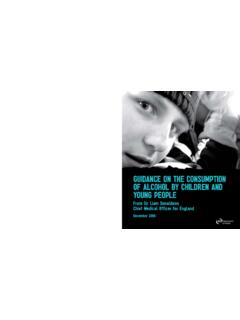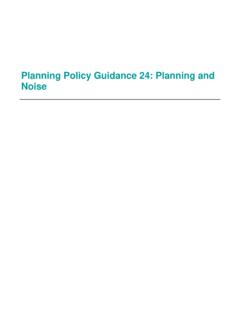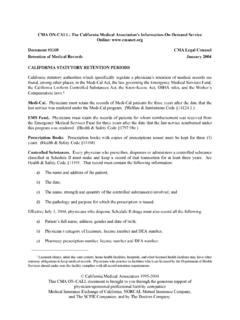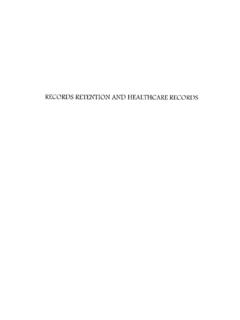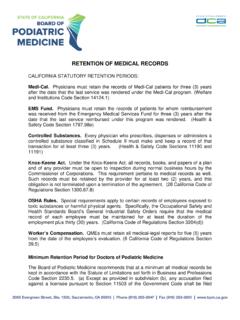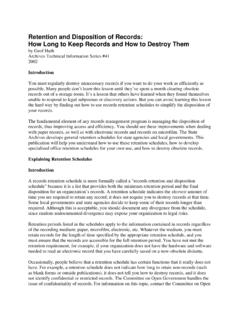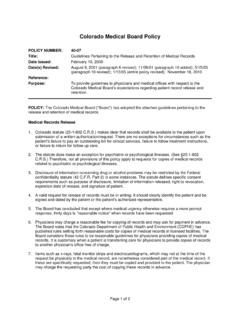Transcription of annex D1: Health Records Retention Schedule
1 annex D1: Health Records Retention Schedule This Retention Schedule details a Minimum Retention Period for each type of Health record . Records (whatever the media) may be retained for longer than the minimum period. However, Records should not ordinarily be retained for more than 30 years. Where a Retention period longer than 30 years is required (eg to be preserved for historical purposes), or for any pre-1948 Records , The National Archives (see note 1 below) should be consulted. Organisations should remember that Records containing personal information are subject to the Data Protection Act 1998. The following types of record are covered by this Retention Schedule (regardless of the media on which they are held, including paper, electronic, images and sound, and including all Records of NHS patients treated on behalf of the NHS in the private healthcare sector): patient Health Records (electronic or paper-based, and concerning all specialties, including GP medical Records ); Records of private patients seen on NHS premises; Accident & Emergency, birth and all other registers; theatre, minor operations and other related registers; X-ray and imaging reports, output and images; photographs, slides and other images; microform (ie microfiche/microfilm);audio and video tapes, cassettes, CD-ROMs, etc; e-mails; computerised Records .
2 And scanned documents. If viewed in electronic format, the search facility in Word or PDF can be used to search for particular record types. 7 Records Management: NHS Code of Practice Part 2 Notes Where an organisation has an existing relationship with an approved Place of Deposit, it should consult the Place of Deposit in the first instance. Where there is no pre-existing relationship with a Place of Deposit, organisations should consult The National Archives. The coding below denotes the status of the type of record and its Retention period: C = a previously existing record type (ie referenced in the previous Retention Schedule dated March 2006) but a Change to the Retention period N =a New record type (either not referenced in the previous Retention Schedule or a more explicit description of a record type than previously published) S = a previously existing record type, with the Same Retention period.
3 8 annex D1: Health Records Retention Schedule TYPE OF Health record MINIMUM Retention PERIOD DERIVATION FINAL ACTION CODE(see note 2) A&E Records (where these are stored separately from the main patient record ) Retain for the period of time appropriate to the patient/specialty, eg children s A&E Records should be retained as per the Retention period for the Records of children and young people Destroy under confidentialconditions S A&E registers (where they exist in paper format) 8 years after the year to which they relate Likely to have archival value. See note 1 S Abortion Certificate A (Form HSA1) and Certificate B (Emergency Abortion) 3 years Destroy under confidentialconditions S Admission books (where they exist in paper format) 8 years after the last entry Likely to have archival value.
4 See note 1 S Adoption Records (administrative) see non Health Records 9 annex D1: Health Records Retention Schedule Records Management: NHS Code of Practice Part 2 TYPE OF Health record MINIMUM Retention PERIOD DERIVATION FINAL ACTION CODE(see note 2) Pre Adoption Records Records , where the NHS number has been changed following adoption, will be returned to the appropriate PCT and they should be retained securely and confidentially for the same period of time as all Records for children and young people. Genetic information should be transferred across to the post adoption until the patient s 25th birthday or 26th if young person was 17 at conclusion of treatment, or 8 years after death. If the illness or death could have potential relevance to adult conditions or have genetic implications for the family of the deceased, the advice of clinicians should be sought as to whether to retain the Records for a longer period Destroy under confidentialconditions N Ambulance Records patient identifiable component (including paramedic Records made on behalf of the Ambulance Service) 10 years (applies to ALL Ambulance Clinical Records )NB Where a patient is transferred to the care of another NHS organisation all relevant clinical information must be transferred to the patients Health record held at that organisation)
5 Limitation Act Destroy under confidentialconditions N Angiography tapes and disks 8 years Destroy under confidentialconditions N Asylum seekers and refugees (NHS personal Health record patient held record ) Special NHS record patient held no requirement on NHS to retain S 10 annex D1: Health Records Retention Schedule TYPE OF Health record MINIMUM Retention PERIOD DERIVATION FINAL ACTION CODE(see note 2) Audio tapes of calls requesting care (PCT, GP, NHS Direct Records etc) Retain taped calls for 3 years providing all relevant clinical information has been transferred to the appropriate patient the information is NOT transferred into a Health record , the tapes should be retained for 10 years. Limitation Act 1980 Destroy under confidentialconditions N Audiology Records Retain for the period of time appropriate to the patient/specialty, eg children s Records should be retained as per the Retention period for the Records of children and young people; mentally disordered persons (within the meaning of the Mental Health Act 1983) 20 years after the last entry in the record or 8 years after the patient s death if patient died while in the care of the organisation Destroy under confidentialconditions S Audit Trails (Electronic Health Records ) NHS organisations are advised to retain all audit trails until further notice.
6 Destroy under confidentialconditions N Autopsy Records see Post mortem Records and registers Birth registers (ie register of births kept by the hospital) Lists sent to General Register Office on a monthly basis. Retain for 2 years Likely to have archival value. See note 1 S Birth Notification (to Child Health Department) Retain until the patient s 25th birthday or 26th if young person was 17 at conclusion of treatment, or 8 years after death. Destroy under confidentialconditions N 11 annex D1: Health Records Retention Schedule Records Management: NHS Code of Practice Part 2 TYPE OF Health record MINIMUM Retention PERIOD DERIVATION FINAL ACTION CODE(see note 2) Blood transfusion Records (see pathology Records )Body release forms 2 years Destroy under confidentialconditions S Breast screening X rays (see Mammography Screening)Care Records compiled by employees of a Care Trust (including information on an individual s educational status, care needs, etc) Retain for the period of time appropriate to the patient/specialty, eg children s Records should be retained as per the Retention period for the Records of children and young people.
7 Mentally disordered persons (within the meaning of the Mental Health Act 1983) 20 years after the last entry in the record or 8 years after the patient s death if patient died while in the care of the organisation Destroy under confidentialconditions S Cervical screening slides 10 years Destroy under confidentialconditions S Chaplaincy Records 2 years Likely to have archival value. See note 1 S 12 annex D1: Health Records Retention Schedule TYPE OF Health record MINIMUM Retention PERIOD DERIVATION FINAL ACTION CODE(see note 2) Child and family guidance Retain for the period of time appropriate to the patient/specialty, eg children s Records should be retained as per the Retention period for the Records of children and young people; mentally disordered persons (within the meaning of the Mental Health Act 1983) 20 years after the last entry in the record or 8 years after the patient s death if patient died while in the care of the organisation Destroy under confidentialconditions S Child Health record Retain until the patient s 25th birthday or 26th if young person was 17 at conclusion of treatment, or 8 years after death.
8 If the illness or death could have potential relevance to adult conditions or have genetic implications for the family of the deceased, the advice of clinicians should be sought as to whether to retain the Records for a longer period Destroy under confidentialconditions N Child Health Records (notification of Visitors/New Entrants into a borough either from abroad, or from within the UK from Airports, the Home Office Immigration Centre and the Housing Options Teams) Database of notifications entries should be retained for 2 yearsWhere a Health visitor visits the child the record of the visit should become part of the patient s record and retained until their 25th birthday or 26th birthday if an entry was made when the patient was 17 or 10 years after the patient s death if patient died while in the care of the organisation.
9 This also applies to any other information that relates to patient care recorded by the Health visitor for these purposes. Other information should be retained for a period of 2 years from the end of the year to which it relates. Destroy under confidentialconditions N 13 annex D1: Health Records Retention Schedule Records Management: NHS Code of Practice Part 2 TYPE OF Health record MINIMUM Retention PERIOD DERIVATION FINAL ACTION CODE(see note 2) Child Protection Register ( Records relating to) Retain until the patient s 26th birthday or 8 years after the patient s death if patient died while in the care of the organisation Destroy under confidentialconditions C Children and young people (all types of Records relating to children and young people) Retain until the patient s 25th birthday or 26th if young person was 17 at conclusion of treatment, or 8 years after death.
10 If the illness or death could have potential relevance to adult conditions or have genetic implications, the advice of clinicians should be sought as to whether to retain the Records for a longer period Destroy under confidentialconditions S Clinical audit Records 5 years Destroy under confidentialconditions S Clinical Protocol (GP, in house) 25 years Destroy under confidentialconditions N Clinical psychology 20 years See note 1 C Clinical trials (see research Records ) 14 annex D1: Health Records Retention Schedule TYPE OF Health record MINIMUM Retention PERIOD DERIVATION FINAL ACTION CODE(see note 2) Contraception and Sexual Health Records (Including where a scan is undertaken prior to termination of pregnancy but the patient goes elsewhere for the procedure) 8 years (in adults) or until 25th birthday in a child (age 26 if entry made when young person was 17), or 8 years after deathSee also Guidance on the Retention and Disposal of Hospital Notes, British Association for Sexual Health and HIV (BASHH) Clinical Standards Committee,Faculty of Sexual and Reproductive Healthcare (FSRH) of the Royal College of Obstetricians and GynaecologistsNB The longest license period for a contraceptive device is 10 years N 15 annex D1.






